
|
|

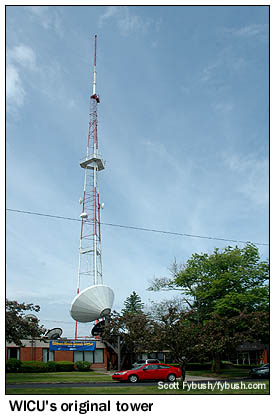 June 26, 2009
June 26, 2009
Big Changes in Erie, PA
For a small market - #142 in the most recent rankings by Nielsen - Erie, Pennsylvania has always been an interesting place for television.
It was one of the first small markets to get a TV station, way back in 1949, and for many decades thereafter it was the scene of spirited competition among three scrappy local operations, launching many careers and sending many talented broadcasters on to bigger stations in bigger markets.
As the economics of local TV have changed in recent years, though, so has Erie - and it's becoming a laboratory of sorts for the ways in which small-market stations are transforming themselves to survive in the 21st century.
We made the three-hour drive from Rochester one sunny day late in May, just as a few big changes were about to hit - and so what we present this week is a snapshot of a market deep in transition.
We started our visit to Erie in the most appropriate place: the WICU (Channel 12) studio building at 3514 State Street, in a leafy residential neighborhood south of downtown Erie. It was from this building - well, at least the central portion of it, since it's been expanded several times over the years - that television in Erie began way back on March 15, 1949. The idea that television could be produced on a tight budget in a small city was so revolutionary at the time that Life magazine sent a crew to Erie to visit station founder Edward Lamb for a photo spread all about how WICU thrived with a small, do-anything staff and a basic, but functional, facility.
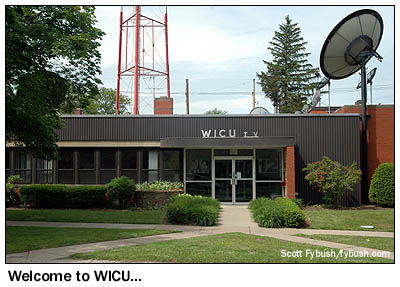
|
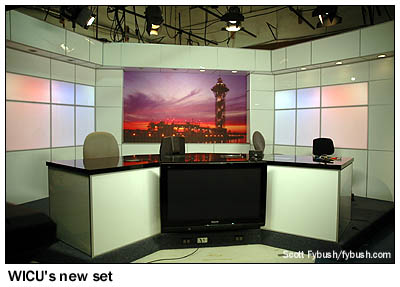
|
At one time, WICU had a radio side as well (on 1330, originally WIKK, later WRIE, now WFNN), and it had its original TV transmitter right here at the back of the building, feeding an antenna atop the self-supporting tower behind the studio. The transmitter eventually moved to the hills south of Erie (we'll get there at the end of this week's installment), and radio moved out before long, but WICU-TV thrived even as UHF competitors came to town in the sixties.
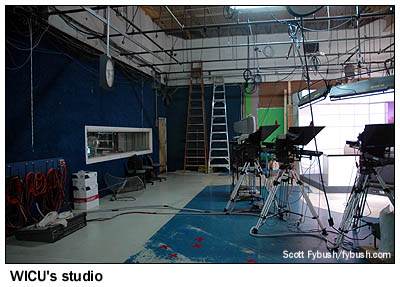
|
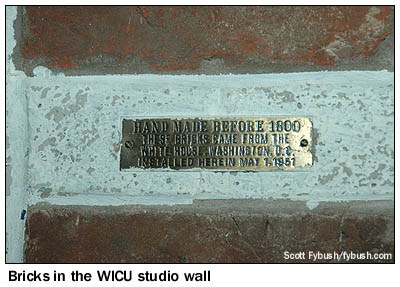
|
Inside the front door, the building is divided roughly in thirds: to the left are sales and management offices, in an area that was largely added on to the building in its later years. The technical core lies straight ahead, and we'll come back there in a moment. To the right is a small newsroom, and beyond that the original studio from 1949, complete with the original window looking into the control room from back in the days when TV station designers believed in the need for studio windows.
WICU had just inaugurated a brand-new news set a few days before our visit, but there's still history to be seen in this large, L-shaped studio - on the wall behind the chromakey screen for the weather, a brass plaque notes several bricks that were brought to Erie from the renovation of the White House in the early 1950s.
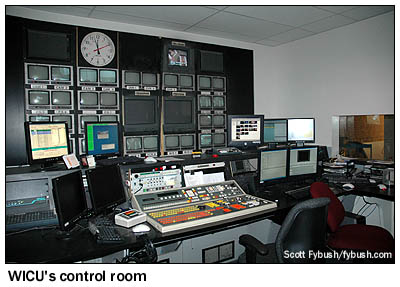
|
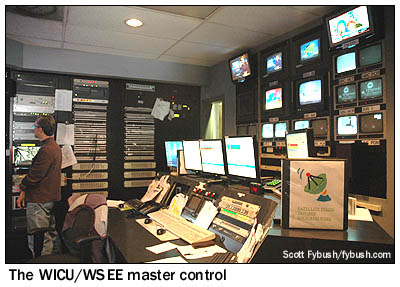
|
On the other side of the window, there's an older - but very serviceable - control room for newscasts, and beyond it a very modern master control facility that now handles a whole slew of feeds. There's WICU's own signal, of course - and for the last few years, a former competitor, CBS affiliate WSEE (Channel 35).
WSEE came into the family quite literally by way of "family" - it and WICU were both acquired by members of the Lilly family, and their operations have slowly been combined into WICU's facilities. The first phase of WSEE's operations to make the move south to State Street was master control - and that means not only WSEE itself but also its CW subchannel, "WBEP," and the unusual CBS feed that WSEE provides to the Caribbean islands, complete with island weather provided by Erie-based, tropical-shirt-wearing meteorologists.
They're doing some exciting things here with multi-station automation, including the impending launch of a 24-hour weather channel specifically for the Caribbean, where WSEE maintains a sales staff and where it enjoys some very avid, loyal viewers who probably never expected to know so much about Erie, Pennsylvania!
WSEE's sales department moved to the WICU facility over the winter, and on the day we visited, WSEE's newsroom was on the verge of being integrated into the WICU building - which meant, sadly, that some of the remaining newspeople there were in their final days of work at WSEE. So what we're about to see, as we drive north from WICU to WSEE, is truly a "last visit" in many senses - but also an opportunity to preserve some broadcast history before being lost forever.
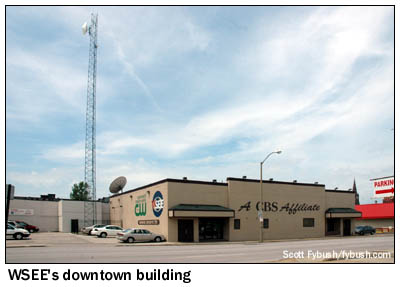
|
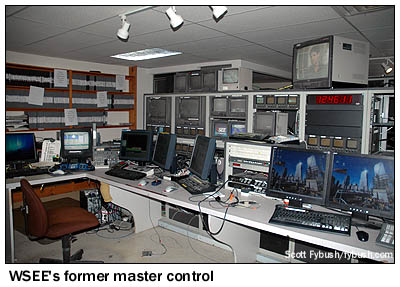
|
Since its debut in the fifties, WSEE had operated from a squat, windowless concrete-block bunker in the heart of downtown Erie, a block north of the train station. We'd driven by 1220 Peach Street many times, but our late-May visit was the first (and last) time we'd get to go inside.
While the building had already been largely vacated by that point, it was easy to see how functional this building had been: with a two-story studio space at its core, the rest of the WSEE facility was laid out in a ring surrounding the studio, partially at ground level and partially in a second-story loft reached by stairways leading up from both sides of the studio.
The lobby was on the left, while the control rooms were on the right side of the building, as viewed from Peach Street. (What's shown above is the newscast control room in its final days; shows were being produced here using Parkervision automation, then sent to the new master control at WICU after the move; the former WSEE master control area was just beyond the area shown in our photo.) WSEE's promotions and engineering departments (still partly active) and a lounge area completed the circuit around the studio, on the first floor to the rear.
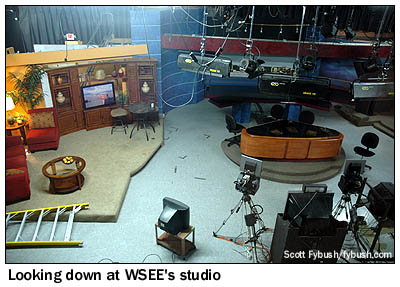
|
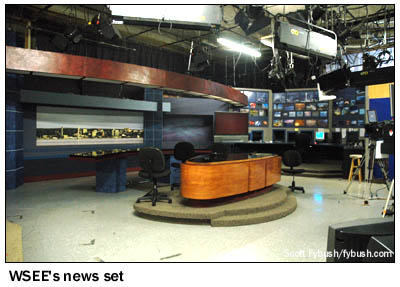
|
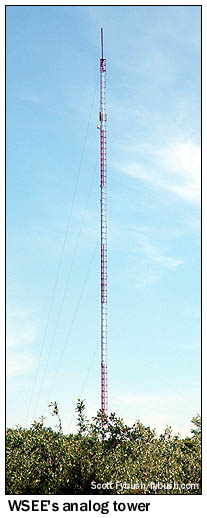
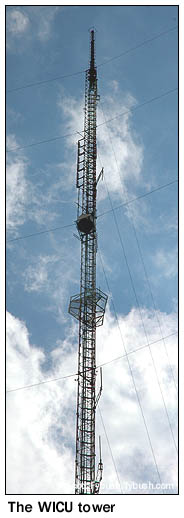 Upstairs, the sales
area at the rear was already empty, but the newsroom, directly
above the lobby on the left side of the building, still showed
some signs of life as WSEE entered its final days with a separate
news operation.
Upstairs, the sales
area at the rear was already empty, but the newsroom, directly
above the lobby on the left side of the building, still showed
some signs of life as WSEE entered its final days with a separate
news operation.
Look closely at the photo below and you can see the windows, on the left side of the picture, that looked down into the spacious studio where so much WSEE programming originated for more than 50 years - and which would go dark just a day after our visit.
It's not easy to run a small-market TV station these days, and it may be that Erie, like so many other 100+ markets, simply can no longer sustain three competing local newsrooms; in any event, the news that's now seen on WSEE comes from the WICU facility, in a transition process that's still underway as the Lilly stations sort out the quirks of producing two newscasts in the same studio at once, and of scheduling newscasts on two stations to best complement each other while still preserving some semblance of individual branding.
It's a challenge many stations around the country will be meeting in the years to come, we're sure - and we'll be watching closely to see how it all works out in Erie (and Elmira, and Binghamton, and Youngstown, and Scranton, and Fort Wayne, and...)
Even with the consolidation, and the unfortunate job cuts that went with it, Erie at least still has two fully competitive newsrooms - and it was from the parking lot of the "other" stations (WJET/WFXP, which we'll visit in next week's installment), on Peach Street south of town near I-90, that we looked over to the former WSEE tower.
WSEE stopped broadcasting on analog channel 35 from that site back in February, leaving the tower standing as a rental property. WSEE-DT (RF 16) comes from another site a few miles to the east - the tower in Greene Township that's been home to WICU since the 1960s.
That site, too, was in the midst of big changes when we visited: WICU-DT's temporary channel 52 facility was just a few days away from going silent forever, as was WICU's analog transmitter. It went dark for good on June 8, ending the era of analog TV in Erie after 60 years and clearing the way for WICU-DT to move to channel 12.
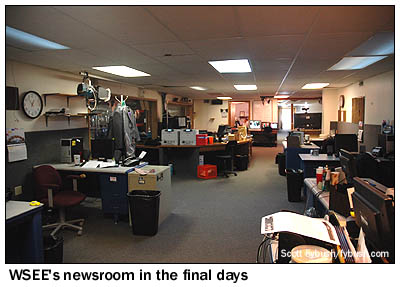
|
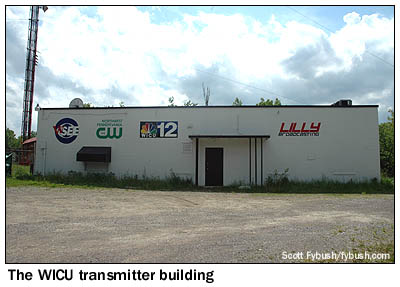
|
We didn't get a transmitter tour this time - with all the work that was underway to combine the WICU and WSEE operations, we were grateful for even the limited amount of time chief engineer John Wilkosz could spare to show us the studios - but we hope to get back sometime soon to see this site, and to see the finished product on State Street, too.
- Previous Site of the Week: Analog TV - The End (part 2)
- Next Week: Erie, Pennsylvania TV, part 2
- Site of the Week INDEX!
- How can you help support Site of the Week? Click here!
- Submit your suggestions for a future Site of the Week!
